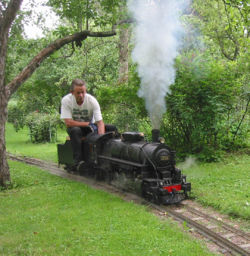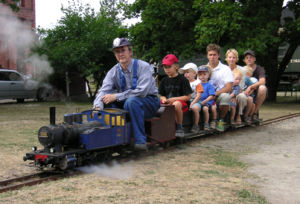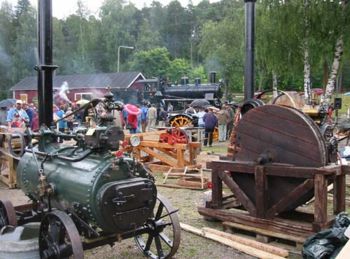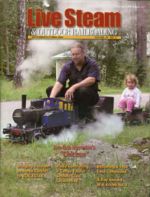Live steam
Live steam is steam under pressure, obtained by heating water in a boiler. The steam is used to operate stationary or moving equipment. See steam engine, steam locomotive, steam roller, stationary engine, steamboat, traction engine. Live steam is also used to produce sound in steam whistles.
Contents
Festivals
A live steam festival (often called a live steam "meet" in the USA) is a gathering of people interested in steam technology. Locomotives, trains, steam rollers and tractors, steam boats and stationary steam engines may be on display, both full-sized and in miniature. Rides may also be offered.
Scale models and railroads

The term live steam also refers to a model steam locomotive, or any other steam-operated model that is powered by steam produced by boiling water. Steam rollers and traction engines are popular, in 1:4 or 1:3 scale, as are stationary model steam engines, ranging from pocket-size to 1:2 scale.
Ridable, large scale live steam railroading on a backyard railroad is probably the most popular aspect of the live steam hobby, but it time-consuming to build a locomotive from scratch and it can be costly to purchase one already built. Garden railways, in smaller scales than can pull a "live" person or be ridden on, offer the excitement of real steam engines, and at lower cost and in less space, but do not provide the same thrill as riding behind one's own locomotive.
One of the most famous live steam railroads was Walt Disney's Carolwood Pacific Railroad, which inspired Disney to surround his planned Disneyland amusement park with a working, narrow gauge railroad.
There are now hundreds of "clubs" and perhaps thousands of private, backyard railroads. The world's largest live steam layout, with over 25 miles (40 km) of trackage is Train Mountain in Chiloquin, Oregon, USA. Another notable layout is the one operated by Los Angeles Live Steamers.
Technology
A live steam locomotive is often an exact, handcrafted scale model. The ridable track gauges range from 2-1/2" to 15", the most popular being in the 4-3/4" to 7-1/2" range. Gauges from 10" (254 mm) and up are called "Miniature Railways" (in the USA these are known as "Grand Scale Railroads"), and are used mostly in amusement park rides and commercial settings.
A wide variety of boiler designs are available, ranging from simple externally fired pot boilers to sophisticated multi-flue internally fired boilers and even superheater boilers usually found only on larger, more complex models.
Fuels

There are several common fuels used to boil water in live steam models, depending on their scale:
Small scales:
- Hexamine fuel tablets - which produce relatively little heat but are cheap and relatively safe. They are often used on "toy" live steam locomotives such as the range produced by Mamod.
- Methylated spirit, (methanol/ethanol mixture) - which burns hotter than solid fuel, but is more dangerous.
- Butane gas - clean burning and safe, but relatively expensive to engineer the burners.
- Electricity - delivered via the track and used to boil the water in an immersion boiler. In 2003, Hornby launched a range of OO gauge models that run from a 12 volt power supply, making this method safer than previous, higher voltage versions.
Large scales:
- Oil - also a popular fuel for large, ridable trains.
- Propane gas - an alternative to coal or oil in large-scale models.
- Coal - which is the prototypical fuel for most full-sized steam locomotives, and the preferred fuel for ridable trains. It can also be used on boilers down to at least 16mm:1 foot scale.
Live Steam magazine
"Live Steam" is a U.S. magazine, founded in 1966 and devoted to the live steam hobby, as well as to other uses of miniature and full-size steam. Originally, it was a mimeographed newsletter, but soon expanded into magazine format. In 2005, the name was changed to Live Steam & Outdoor Railroading. It is currently published bi-monthly, in full color, with a press run of slightly over 10,000 (Dec. 2004).
External links
- Building Live Steam trains
- Hornby Live Steam
- Live Steam Magazine official website
- Live Steam by Father Finelli
- www.discoverlivesteam.com - List of Live Steam railroads
- Live Steam Clubs & Resources Directory of live steam railroad clubs and modeling resources


